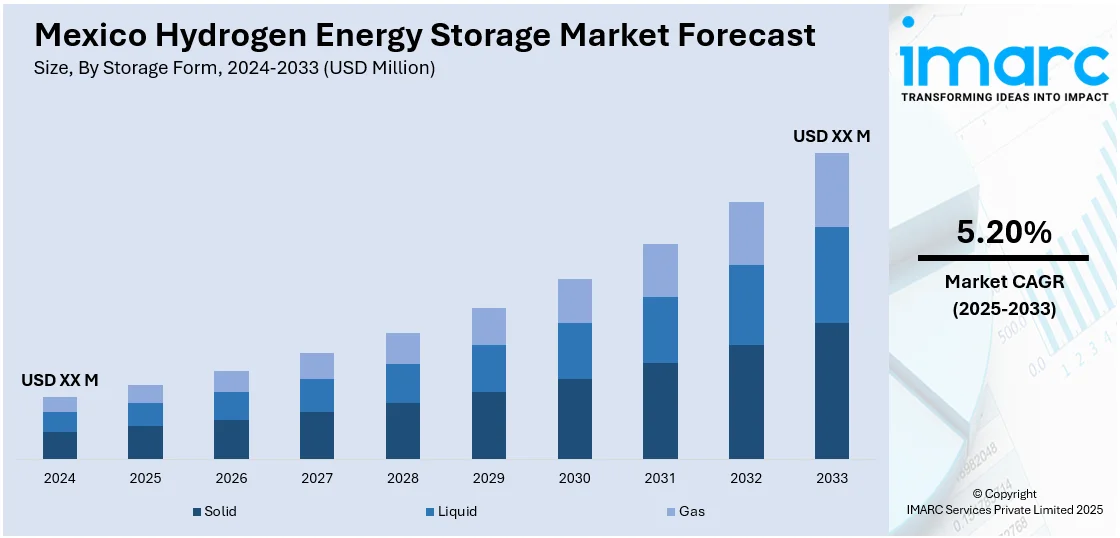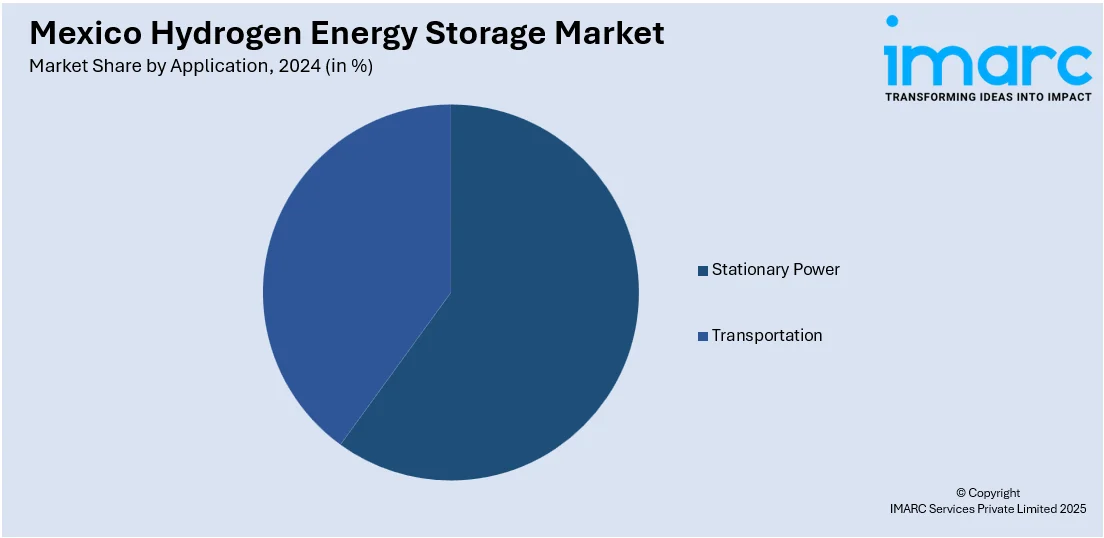
Mexico Hydrogen Energy Storage Market Size, Share, Trends and Forecast by Storage Form, Technology, Application, End User, and Region, 2025-2033
Mexico Hydrogen Energy Storage Market Overview:
The Mexico hydrogen energy storage market size is projected to exhibit a growth rate (CAGR) of 5.20% during 2025-2033. The market is driven by the increasing investments in renewable energy and grid stability concerns. Additionally, the implementation of government initiatives promoting green hydrogen production, along with collaborations between domestic and international energy players, are accelerating infrastructure development across the region. Moreover, the rising demand for long-duration storage, industrial decarbonization, and improved electrolyzer technologies are important factors augmenting Mexico hydrogen energy storage market share.
|
Report Attribute
|
Key Statistics
|
|---|---|
|
Base Year
|
2024 |
|
Forecast Years
|
2025-2033
|
|
Historical Years
|
2019-2024
|
| Market Growth Rate 2025-2033 | 5.20% |
Mexico Hydrogen Energy Storage Market Trends:
Expansion of Green Hydrogen Projects for Grid Stability and Renewable Integration
The market is witnessing increased focus on green hydrogen projects aimed at stabilizing the grid and integrating renewable energy sources. For instance, on February 18, 2025, Aslan Energy Capital announced the Aslan Net-Zero Energy Mexico Project, a green hydrogen and ammonia production initiative powered by solar energy in Sonora, Mexico. The project aims to supply carbon-free hydrogen and ammonia to California-based CalYan XGH for downstream distribution and infrastructure within the state, supporting California's clean energy demand. The project is scheduled for completion by 2028. As solar and wind capacity expand, especially in northern and central regions, intermittency issues are becoming a growing concern for national grid operators. Hydrogen produced via electrolysis using surplus renewable energy is being explored as a buffer to balance supply-demand mismatches. Pilot projects supported by CFE (Federal Electricity Commission) and foreign investors are validating hydrogen’s role in absorbing excess power during peak generation and releasing it during demand spikes. This trend is particularly relevant given Mexico’s target of reaching clean energy targets under its General Law on Climate Change. Moreover, green hydrogen’s potential to be reconverted into electricity through fuel cells or gas turbines provides an additional layer of energy security. This storage mechanism is especially valuable in remote or industrially intensive zones where consistent power delivery is critical.

Industrial Decarbonization Initiatives Using Hydrogen as a Feedstock and Storage Medium
Major Mexican industries, particularly in steel, cement, and chemicals, are beginning to adopt hydrogen as part of their decarbonization roadmaps. This shift is partly driven by the country's enhanced climate commitments, which now target a 35% reduction in greenhouse gas (GHG) emissions by 2030, up from 22% in the 2020 submission. If supported by international cooperation, the target could rise to 40%, surpassing the earlier conditional goal of 36%. Industrial clusters in states like Nuevo León and Coahuila are exploring hydrogen energy storage solutions to manage process heat and ensure production continuity during power disruptions. This is providing a boost to Mexico hydrogen energy storage market growth. PEMEX and other national entities are also assessing the use in refining and petrochemical applications to align with global carbon-reduction commitments. Companies are evaluating on-site electrolysis systems combined with storage tanks and compression technologies to reduce reliance on fossil-derived hydrogen. In many cases, excess hydrogen is stored during periods of low demand or surplus energy availability and reused when peak operations require high energy input. This trend is also driving interest in co-locating renewable energy facilities with hydrogen production and storage infrastructure.
Mexico Hydrogen Energy Storage Market Segmentation:
IMARC Group provides an analysis of the key trends in each segment of the market, along with forecasts at the country and regional levels for 2025-2033. Our report has categorized the market based on storage form, technology, application, and end user.
Storage Form Insights:
- Solid
- Liquid
- Gas
The report has provided a detailed breakup and analysis of the market based on the storage form. This includes solid, liquid, and gas.
Technology Insights:
- Compression
- Liquefaction
- Material Based
A detailed breakup and analysis of the market based on the technology have also been provided in the report. This includes compression, liquefaction, and material based.
Application Insights:

- Stationary Power
- Transportation
The report has provided a detailed breakup and analysis of the market based on the application. This includes stationary power and transportation.
End User Insights:
- Utilities
- Industrial
- Commercial
A detailed breakup and analysis of the market based on the end user have also been provided in the report. This includes utilities, industrial, and commercial.
Regional Insights:
- Northern Mexico
- Central Mexico
- Southern Mexico
- Others
The report has also provided a comprehensive analysis of all the major regional markets, which include Northern Mexico, Central Mexico, Southern Mexico, and others.
Competitive Landscape:
The market research report has also provided a comprehensive analysis of the competitive landscape. Competitive analysis such as market structure, key player positioning, top winning strategies, competitive dashboard, and company evaluation quadrant has been covered in the report. Also, detailed profiles of all major companies have been provided.
Mexico Hydrogen Energy Storage Market Report Coverage:
| Report Features | Details |
|---|---|
| Base Year of the Analysis | 2024 |
| Historical Period | 2019-2024 |
| Forecast Period | 2025-2033 |
| Units | Million USD |
| Scope of the Report |
Exploration of Historical Trends and Market Outlook, Industry Catalysts and Challenges, Segment-Wise Historical and Future Market Assessment:
|
| Storage Forms Covered | Solid, Liquid, Gas |
| Technologies Covered | Compression, Liquefaction, Material Based |
| Applications Covered | Stationary Power, Transportation |
| End Users Covered | Utilities, Industrial, Commercial |
| Regions Covered | Northern Mexico, Central Mexico, Southern Mexico, Others |
| Customization Scope | 10% Free Customization |
| Post-Sale Analyst Support | 10-12 Weeks |
| Delivery Format | PDF and Excel through Email (We can also provide the editable version of the report in PPT/Word format on special request) |
Key Questions Answered in This Report:
- How has the Mexico hydrogen energy storage market performed so far and how will it perform in the coming years?
- What is the breakup of the Mexico hydrogen energy storage market on the basis of storage form?
- What is the breakup of the Mexico hydrogen energy storage market on the basis of technology?
- What is the breakup of the Mexico hydrogen energy storage market on the basis of application?
- What is the breakup of the Mexico hydrogen energy storage market on the basis of end user?
- What is the breakup of the Mexico hydrogen energy storage market on the basis of region?
- What are the various stages in the value chain of the Mexico hydrogen energy storage market?
- What are the key driving factors and challenges in the Mexico hydrogen energy storage market?
- What is the structure of the Mexico hydrogen energy storage market and who are the key players?
- What is the degree of competition in the Mexico hydrogen energy storage market?
Key Benefits for Stakeholders:
- IMARC’s industry report offers a comprehensive quantitative analysis of various market segments, historical and current market trends, market forecasts, and dynamics of the Mexico hydrogen energy storage market from 2019-2033.
- The research report provides the latest information on the market drivers, challenges, and opportunities in the Mexico hydrogen energy storage market.
- Porter's five forces analysis assist stakeholders in assessing the impact of new entrants, competitive rivalry, supplier power, buyer power, and the threat of substitution. It helps stakeholders to analyze the level of competition within the Mexico hydrogen energy storage industry and its attractiveness.
- Competitive landscape allows stakeholders to understand their competitive environment and provides an insight into the current positions of key players in the market.
Need more help?
- Speak to our experienced analysts for insights on the current market scenarios.
- Include additional segments and countries to customize the report as per your requirement.
- Gain an unparalleled competitive advantage in your domain by understanding how to utilize the report and positively impacting your operations and revenue.
- For further assistance, please connect with our analysts.
 Request Customization
Request Customization
 Speak to an Analyst
Speak to an Analyst
 Request Brochure
Request Brochure
 Inquire Before Buying
Inquire Before Buying




.webp)




.webp)












